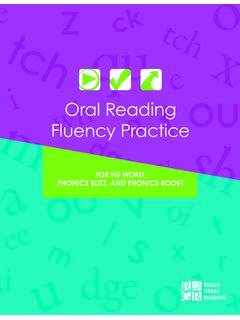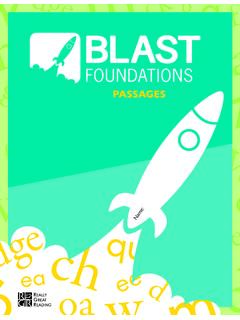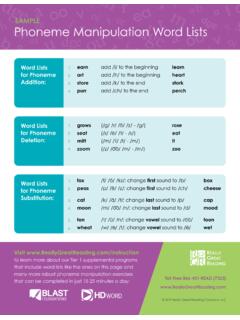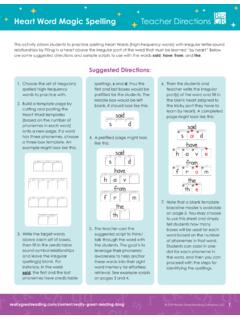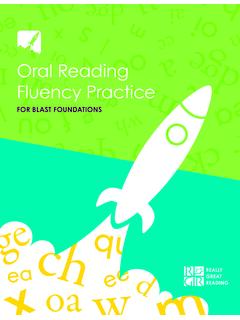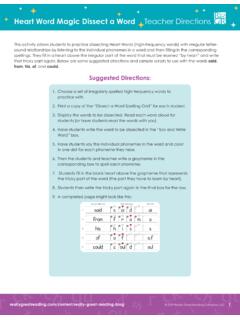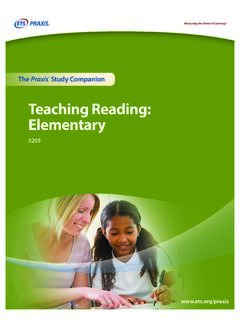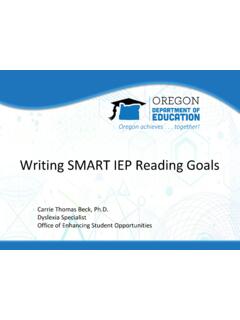Transcription of Complimentary Diagnostic Version DecoDing surveys
1 DiagnosticDecoDing surveysBeginning DecoDing SurveyAdvanced DecoDing SurveyComplimentaryVersionForm AMore than 20 years of scientific, evidence-based reading research makes clear that all good readers must master certain basic skills. Those skills include the ability to decode words accurately a skill that most struggling readers have difficulty with. This Complimentary set of Diagnostic DecoDing surveys includes two informal Diagnostic tools designed to quickly pinpoint DecoDing weaknesses in students of almost any Diagnostic DecoDing surveys enable one-on-one assessment of phonics skills for struggling readers from the middle of first grade through adulthood. The surveys are efficient and easy to administer. For students with DecoDing weaknesses, the surveys can be used to identify which skills have already been mastered and which are weak. This Complimentary packet contains everything you ll need for initial assessment of an unlimited number of students.
2 The packet also provides an explanation of how the survey results can be used to group students, and it offers guidance on how to plan effective, efficient Box 46 Cabin John, MD 20818-0046 Toll Free Fax This is the most polished little instrument in existence and many people are grateful that you have shared it. Dr. Louisa Moats National Reading Expert 2010 Really Great Reading Complimentary Version Diagnostic DecoDing surveys1 Diagnostic DecoDing surveysDiagnosticDecoDing surveysComplimentaryVersionForm AContentsOverview ..2 A Brief Explanation of the Diagnostic DecoDing surveys ..2 Two Case Studies ..3 How the Diagnostic DecoDing surveys Support Response to Intervention ..3 Using This Packet ..4 Who Can Use This Packet ..4 How to Administer and score the Diagnostic DecoDing surveys ..4 When to Administer the Diagnostic DecoDing surveys ..4 Criterion-Referenced Benchmarks ..4 Preparing, Administering, and Scoring the surveys .
3 5 Materials Needed ..5 Administration and Scoring Guidelines ..5 Beginning DecoDing survey ..6 Student Page: Words and Sentences to Read Form A ..6 Blackline Master: Recording Form and Error Grid Form A ..7 Summary Script and Sample Scoring Sheet ..8 advanced DecoDing survey ..9 Summary Script and Sample Scoring Sheet ..9 Student Page: Words to Read Form A ..10 Blackline Master: Recording Form and Error Grid Form A ..11 Using the Diagnostic DecoDing surveys to Group Students ..12 The Grouping Matrix ..12 phonics Suite Overview ..13 phonics Suite Professional Development ..14 Seven Steps to Implement phonics Suite ..15 Recording Form Blackline Form ..18 2010 Really Great Reading Complimentary Version Diagnostic DecoDing surveys2 Diagnostic DecoDing surveysOverviewA Brief explAnAtion of the DiA gnostic DecoDing surveysWhen students cannot decode words accurately, their fluency and comprehension of text are affected. Quick, informal Diagnostic assessment of a student s DecoDing skills is the critical first step toward planning effective reading instruction.
4 Teachers who can identify exactly which skills a student has mastered and which skills are weak will be able to group and instruct their students effectively and efficiently. No matter their age, most struggling readers have weaknesses in basic reading skills. The Diagnostic DecoDing surveys contained in this packet allow teachers to: Assess the basic and advanced DecoDing skills of readers of almost any age Establish whether a student has gaps in his/her phonics knowledge and pinpoint specific phonics weaknesses Determine whether the DecoDing skills are being established at an appropriate pace (by comparing the results against some criterion benchmarks by grade and phase of year)The Beginning DecoDing survey assesses students ability to read high-frequency words and single- syllable decodable words with short vowels, digraphs, and advanced DecoDing survey assesses how well students read unfamiliar single- syllable decodable words with more advanced vowel patterns.
5 The advanced DecoDing survey also assesses a student s ability to read familiar and unfamiliar multi- syllable Complimentary packet should be used for initial assessment of students DecoDing skills. You may use the surveys in this set to assess as many students as you d like. If the surveys reveal that a student s weakness is not in DecoDing , you will want to use other instruments to assess possible weaknesses in other basic reading skills. This Complimentary packet includes Form A of the Diagnostic DecoDing surveys . In response to customer feedback, RGR recently published six additional forms that may be used for progress monitoring. In addition, RGR s recently published User s Guide provides comprehensive guidance on how to administer, score , and interpret the Diagnostic DecoDing surveys . The User s Guide includes reproducible copies of the additional forms. In addition, RGR offers a full-day and a half-day Screening and Diagnostic Assessment workshop for teachers or administrators who use or would like to use the Diagnostic DecoDing surveys in their learn more about the additional forms and the User s Guide, please see the order form located on the last page of this document.
6 For access to Complimentary portions of the User s Guide, use the links on the next page. 2010 Really Great Reading Complimentary Version Diagnostic DecoDing surveys3 Diagnostic DecoDing surveystwo cAse stuDiesTo highlight the various pieces of the Diagnostic DecoDing surveys and provide a more detailed overview of this product, RGR has made available two case studies: one of a second-grade student and one of a ninth-grade student. These case studies provide details about each student s screening assessment scores, a detailed analysis of each student s Diagnostic DecoDing surveys scores, and recommendations for additional assessment or specific instructional recommendations. The information presented in the case studies is taken from actual students, but the names have been changed. More case studies are available in the User s Guide. Click here to download the case study document or type this URL into your browser: the DiA gnostic DecoDing surveys support response to interventionThe Diagnostic DecoDing surveys can be an integral part of Response to Intervention (RtI).
7 Many schools use RtI to ensure that students receive appropriate reading instruction prior to being referred for an evaluation for special education services. The Diagnostic DecoDing surveys can provide valuable information during the RtI process. For example, the survey scores show error patterns that can be a part of the information used to plan effective phonics instruction. Effective remediation will fill the gaps that have been identified. The surveys also provide data that can be used to group students effectively if phonics instruction is required. In addition, the surveys can be used to provide progress monitoring data. More information on grouping and progress monitoring using the Grouping MatrixTM can be found on page 12 of this a detailed discussion of how the Diagnostic DecoDing surveys fit into an RtI model, click here or type this URL into your browser: 2010 Really Great Reading Complimentary Version Diagnostic DecoDing surveys4 Diagnostic DecoDing surveysUsing This Packetwho cAn use this pAcketThis is a Complimentary packet provided to you by RGR.
8 As a user of this Complimentary Version , feel free to make as many copies of the recording forms as necessary. If you would like to give this document to a colleague, please have that person request a new copy from the RGR website: to ADminister AnD score the DiA gnostic DecoDing surveysThe Diagnostic DecoDing surveys take less than 10 minutes per student to administer. The surveys are most often used with students in grades 1 12 who have been identified as struggling readers. Learning how to administer and score the Diagnostic DecoDing surveys is quick and easy. To get started, you must become familiar with: Materials Needed (page 5) Administration and Scoring Guidelines (page 5) Summary Scripts and Sample Scoring Sheets (pages 8 and 9)when to ADminister the DiA gnostic DecoDing surveysThe general guidelines below indicate when it is appropriate to administer the Beginning and advanced DecoDing surveys to each grade 1 It is appropriate to administer the Beginning DecoDing survey starting in the middle of first grade.
9 The advanced DecoDing survey should not be administered to first graders at any time during the 2 It is appropriate to administer the Beginning DecoDing survey to second graders at any time during the year. The advanced DecoDing survey should not be administered until the middle of second 3 12 It is appropriate to administer both the Beginning DecoDing survey and the advanced DecoDing survey at any time during the is important to note that the Beginning DecoDing survey should always be administered to students before administering the advanced DecoDing survey . Grade 1 2 3 4 12 and adult Time of Year B | m | E B | m | E B | m | E B | m | E Beginning DecoDing survey na | 36 | 48 48 48 48 advanced DecoDing survey na na | 15 | 20 21 | 23 | 25 26B = Beginning of Year M = Middle of Year E = End of Year NA = We do not recommend giving this survey at this time of year.
10 Criterion-referenceD BenchmArksThe Diagnostic DecoDing surveys were designed for use by students from grades 1 12 and adults. RGR recommends the following benchmark scores. These scores indicate the number of words students are expected to read correctly in both the Beginning DecoDing survey and the advanced DecoDing survey . The chart is broken down by grade level and phase of year. The basis for these benchmarks is discussed in further detail in the User s Guide. Benchmark Scores: Total Words Correct on Beginning and advanced DecoDing surveys 2010 Really Great Reading Complimentary Version Diagnostic DecoDing surveys5 Diagnostic DecoDing surveysPreparing, Administering, and Scoring the SurveysThis page summarizes the necessary materials and the basics of administering and scoring both surveys . More detailed instructions can be found on the Summary Script and Sample Scoring Sheets (pages 8 and 9) as well as in the User s Guide. mAteriAls neeDeDStudent Page Form A.

